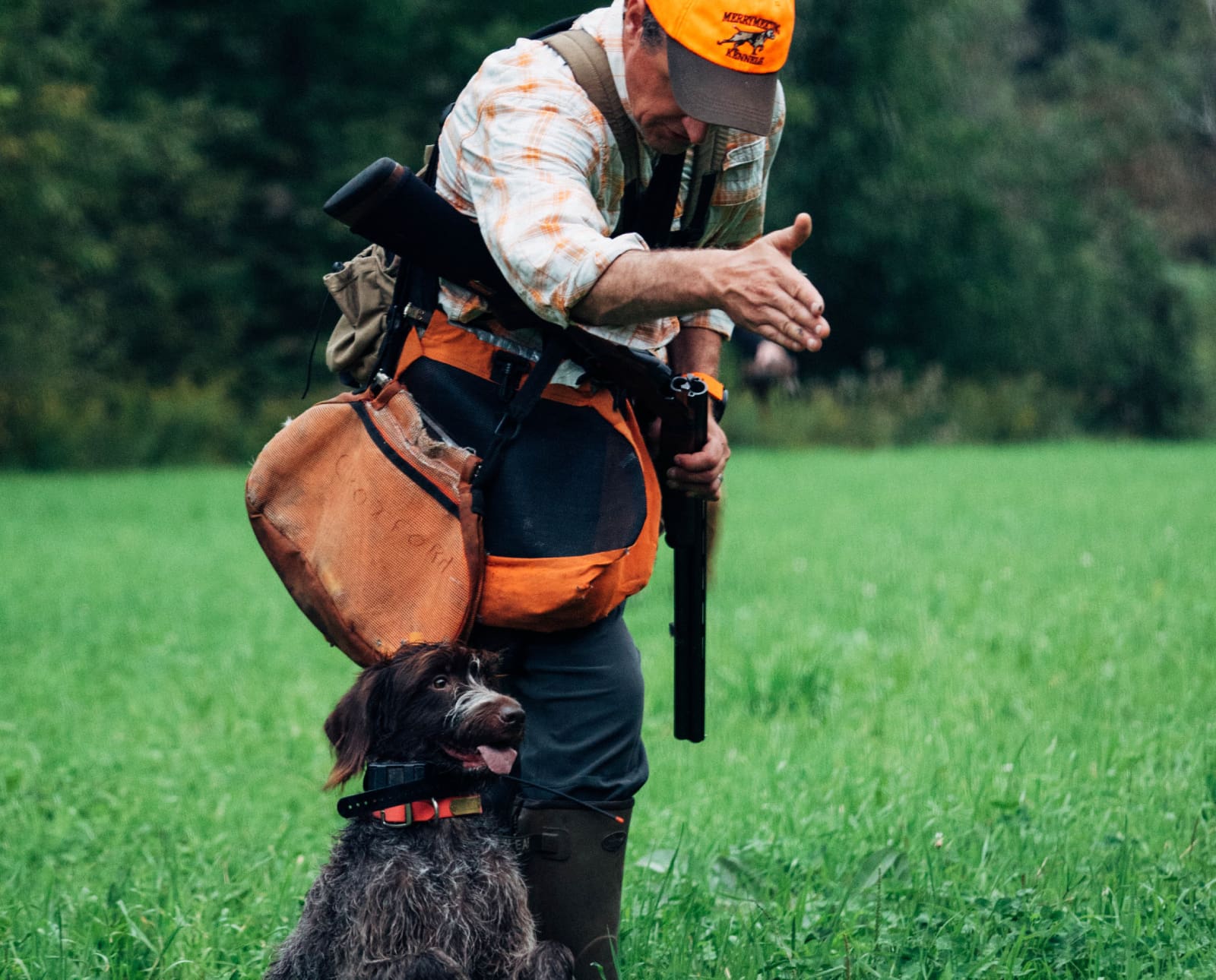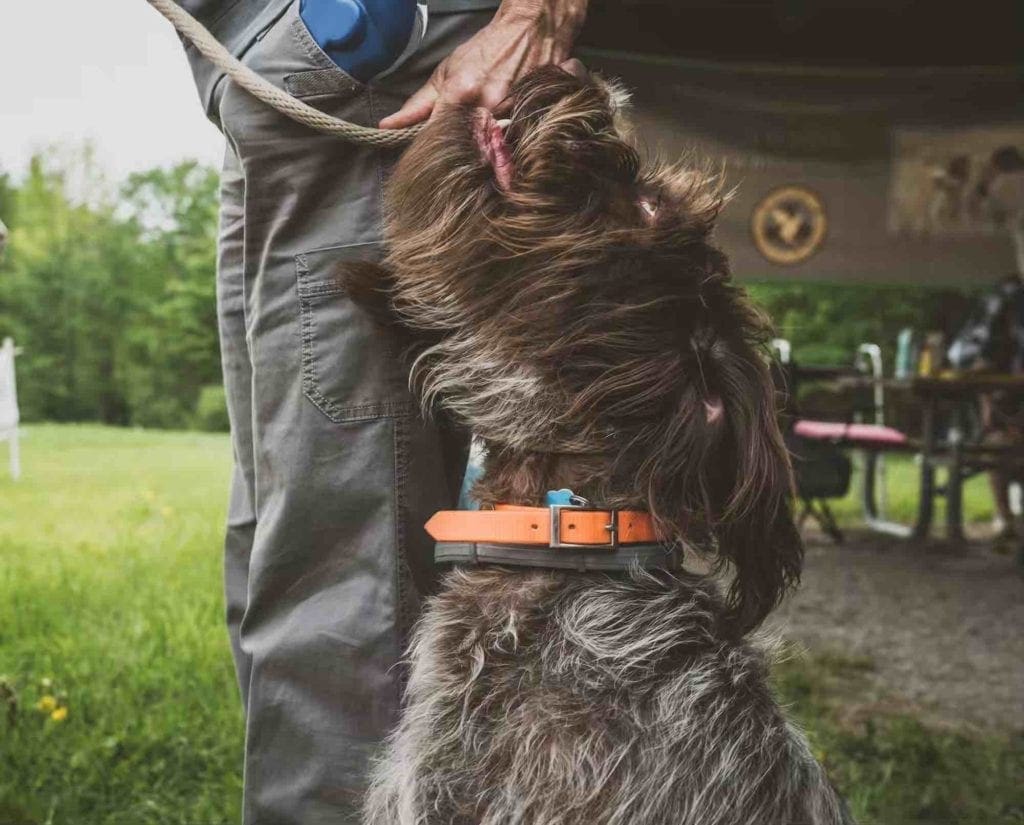Home » Hunting Dogs » How to Correctly Command Your Dog
How to Correctly Command Your Dog

Jason Carter is a NAVHDA judge, NADKC member, director of…
As Commander-in-Chief of your hunting dog, make sure your intended message is clearly understood
“Where were you last night?”
These words strike fear in nearly all adolescent children. Is the parent simply curious? Was it an ambivalent conversation starter or a knowing and accusatory set up? The answer always lies within the subtle tones, expression, and body language of the parent.
Listen to more articles on Apple | Google | Spotify | Audible
The same is true when thinking about the delivery of a command in dog training. It is very important to be cognizant of how we present information to our dogs because they, too, are always studying what we are saying. Know that you can’t hide your emotions within a command, no matter how hard you try. Always try to remain clear, calm, consistent, and absolute when commanding.
The volume and tone of each command should be heard clearly by the dog. Your physical touch and visual cues should silently command the dog towards your desired outcome, not conflict with your words. Speak only when you have something to say. If everything is done properly, the communication highway between you and your dog will remain free from obstructions, which lends itself to quicker and deeper understanding. The following commanding techniques will help you to better communicate with your dog and avoid some of the common mistakes that handlers make.
Commanding Techniques to Avoid
The following personas are examples of common training pitfalls. Understanding these mistakes will help you to become a clear communicator and will improve your training relationship with your dog.
The Over-Commander
We all know those handlers, where commands come flying out of their mouths faster than pops in a popcorn machine. “Come, come, come, heel, heel, come, sit, bad, here, come…” They’ve blown their whistle to the point where you would be happy to help them relocate it someplace else.
It’s important to not over-command in the field. Try to streamline your commands towards only speaking when you have something to say. Never layer commands on top of one another. Be sure that your dog adheres to the first command before giving the second, which will help to prevent command overload.
Over-commanding, more affectionately known as “nagging,” will eventually cause the dog to ignore you. Following a one-command system of training develops an attentive and responsive dog.
The Loud and Proud Trainer
When delivering a command, folks have a tendency to tier the commands with the volume that best aligns with their emotions. For example, you may first start with the “whoa” (stop) command with an appropriate volume that is just enough for the dog to hear. If that doesn’t work, you escalate up to a “whoa” with double the volume and animation. When that doesn’t work, we dive headlong into the “WHOAAAAA!!!” with enough emotion and fury that it inspires us to actually do something about the behavior. Guess which command to which the dog tends to respond best? Yup, you guessed it, the one that you back up with enforcement. They figure that the first two commands are shots across the bow and are waiting for that all-expressive third command that you back up with a correction. If, instead, you acted upon the first command, the dog would have started to respond on the first low-level command.
Remember that dogs can hear incredibly well. Human hearing can detect sounds beginning at 20 hertz and ranging up to 12,000-20,000 hertz. Dogs can hear in the range of 40-60,000 hertz. If you have suspicions that your dog might be ignoring you, guess what, they likely are doing exactly that. There’s no need for the eye-bulging, vein-popping, satanic commands. Save those for the emergency situations that you may someday encounter in the field.
The English Teacher
We all tend to carry our love and admiration of our hunting dogs into the field. We want to tell them all kinds of sweet nothings to let them know how much we care. In humanizing our dogs, we tend to muddy the waters with existential conversation.
You may have noticed that after you shoot your bird and it gets delivered to the bag, your dog isn’t there snuggling and looking for affirmation. Instead, it is licking the blood from its lips and asking to be released so it can get back after it.
Throwing in extra words with our commands forces the dog to have to pull the command from the assortment of ramblings. Remember that humans are humans and dogs are dogs. We act like we do; they act like they do. Being anthropomorphic only benefits you and is detrimental to the dog’s learning. Dogs are capable of understanding many commands, but in the end, they don’t know or comprehend English. Talking to your dog in full sentences is just confusing.

Troubleshooting Problems in Dog Training
It’s been said that good trainers can fix problems, but great trainers never have them. Either way, here are some tips on identifying and correcting problems you may face when learning to command your dog
“Can You Hear Me Now?”
In training, it’s important to know if the dog can hear our commands. Between running, barking, bells, and beepers, there are times when the environmental noises mask our commands. This is especially the case with soft-spoken handlers.
When teaching a new command, keep the pup in proximity for ease of hearing. Also, when the dog is at a distance, whistles are great for a long-range command tool. They carry no emotion to read into and provide clear communication to the dog. I highly recommend whistle training your dog if you haven’t already done so.
“Sorry, Did You Say Something?”
Ever feel like your dog is not hearing a word you’re saying? Sometimes dog training is like the classroom scene from Peanuts, “Wha, wha-wha, wha, wha-wha…” Like a child with ADHD, dogs are very easily distracted and tend to tune you out in stimulating situations. Though frustrating, training with distraction is an important technique to expose weaknesses in your training. It reminds you how very important it is to be able to get your dog’s attention. Getting your dog’s attention before presenting it with a command is essential for understanding and compliance.
“Show Me the Money!”
We tend to want our dogs to listen to us; dogs, on the other hand, prefer that we show them what we want. Dogs pay incredibly close attention to our visual routines in training. How we move, how we stand, where we place our hands and eyes… all of these are silent commands that clue the dog in to the situation and what we are asking.
Timing Takes Time
Timing is everything in dog training. To give the right command at the right time takes some phonetic dexterity. Formulating the correct word to deal with quickly evolving situations takes practice. If you find yourself stumbling over your commands, welcome to dog training! We have all been there. Slow down and focus on getting the dog to listen to the original command before moving onto another. Think ahead, focus hard on your dog, and be ready to give the command when the behavior presents itself. Be in the moment.
Setting the Tone
Growing up, when my parents asked me to clean my room, it was rarely said in a way that left me wondering, hmm, was that just a suggestion? On the contrary, it was clearly communicated that it absolutely needed to be done, immediately and correctly. The tone in their delivery communicated everything I needed to know. They didn’t need to yell or have a fit about it, I just understood what was behind the tone and that the implications for not complying would be swift and compelling.
The same philosophy works in our dog training. Our tone in training should always convey a non-ambiguous order to comply. I prefer using descending, low tones when providing my commands. It helps differentiate the command from my normal speaking patterns that they hear all the time. Dogs also respond well to high or falsetto tones for encouragement and reward. Don’t be afraid to get animated and silly at times to help encourage correct behavior. In the end, we become somewhat theatrical in our training style, full of animation and tonal expression. Your tonal variations in commanding are utilized to build drive and attitude while being careful not to lose accuracy and attention.
We all have different personalities that flow into our training. Issues arise when those personalities interfere with the flow of communication. We want to be as clear and concise as possible when we train. As you and your dog navigate your way through training lessons, the clarity in communication will start to click, and it will start a snowball effect where learning comes quickly. As success builds on success, before you know it, you will be reaching your training goals in no time.
Jason Carter is a NAVHDA judge, NADKC member, director of youth development, secretary of NAVHDA’s youth committee, clinic leader and trainer at Merrymeeting Kennels. He has been around versatile hunting dogs his entire life, literally! Born into the Carter family and Merrymeeting Kennels, he attended his first NAVHDA test in Bowdoinham, Maine, when he was just a year of age. Jason successfully trains, tests and breeds Deutsch Kurzhaars in both the NAVHDA and NADKC testing systems. Through his work at the kennel, Jason has had the opportunity to develop pointers, flushers and retrievers over the years. When October arrives he can be found with family and friends hunting throughout New England.



